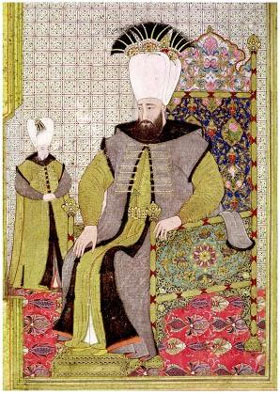|
http://artebru.blogcu.com/osmanli-resim-sanati-minyatur/5909277
http://www.felsefeekibi.com/sanat/sanatalanlari/sanat_alanlari_osmanli_minyaturu_klasik_sonrasi.html
http://yalpturk.blogcu.com/levni-abdulcelil-celebi/1150416
Nakkaş Levni
Ottoman miniature art had its roots in the nomadic times. It was influenced by Persian and Chinese traditions. Artists didn’t always enjoy freedom of expression in the Empire:
İslam akidesinde insan sureti çizilmesi ve heykel yapmak Allah ile boy ölçüşmek gibi algılanmış ve ressamın kimliği çoğu zaman gizli kalmıştır. In the Islamic faith drawing a picture of a human being and making a statue is perceived as competing with Allah, and often the artist’s name was kept a secret.
Miniature painting took a step forward in Fatih Sultan Mehmet’s era. Its classical period can be dated to the reign of Suleiman the Magnificient. The most mature miniatures come from the period of Murad III and young Osman II. The last great miniatyrist, Levni alias Abdülcelil Çelebi, created his masterpieces during the Tulip era.
Çelebi was born in Edirne where he began his career. He was given the nickname Levni ‘colorful’. Levni was also known as a poet and a musician. He painted the portraits of 22 Sultans. Unfortunately the original works have not remained until today. Levni’s most important work, the series Surname-i Vehbi which tells the story of Palace circumcision festivals, is still kept in the library of Topkapi Palace. Levni is praised for his natural compositions, sensitive use of colors and special talent in describing joy of life.
Padişahın badem gözleri, kemerli burnu, koyu sakalı, uzun yüzü, zarif duruşu ve bakışı gerçekçi bir portre olduğunu gösterir. The Sultan’s (Ahmed III) almond eyes, Roman nose, his thick beards, long face, elegant pose and glance show that it is a realistic portrait.

Şehzade düğünlerine oyuncular, hünerli kişiler, fişek ustaları, yazarlar, ressamlar, alim ve şairler katılırdı. Actors, jugglers, firework masters, writers, painters, scholars and poets attended the circumcision festivals of the princes.

Levni´s woman figures broke the earlier tradition:
Levni’nin minyatüre getirdiği en önemli değişiklik kadını erkekler arasındaki silik yaşamın dışına taşıyarak kadını tek başına elinde çiçekle, otururken, uyurken, yatarken ve enstrüman çalarken minyatürleri ile eserlerinde işlemiştir. The biggest difference Levni brought to the miniatyr was taking the woman out of the faceless life among men and presenting her alone: a flower in her hand, sitting, sleeping, lying, playing musical instruments.

Edited (9/28/2012) by Abla
|

